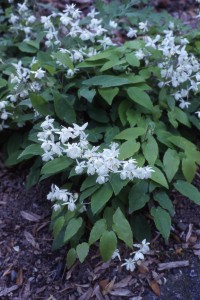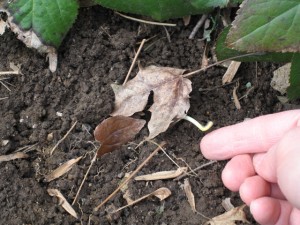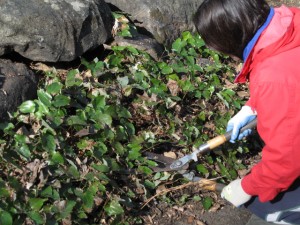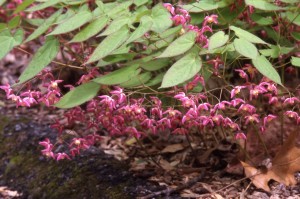Stop Bugging Me!
August 10, 2010 by admin
Filed under Techniques
When you work outdoors for nine months out of the year, you become very focused on physical comfort. So, while other women may obsess over designer clothes, I have a “thing” for outerwear and work shoes. Let’s put it this way: I won’t be lusting after any Manolo Blahniks until they come out with a waterproof, steel-toed line (although it has occurred to me that those pointy-toed stilettoes lots of women wear might be useful for digging out dandelions).

Hmmm...despite their potential as dandelion weeders, I won't be wearing these in the garden any time soon!
Generally, being comfortable means finding clothes and accessories that keep you dry, at a suitable temperature, and free of bites and scratches. Today I’m going to share with you one of the things I do to take care of that last bit: come home from work without being covered with welts from the thousands of insects that want a piece of me every day.
Insect bites anywhere are annoying, but what really gets to me is when hundreds of tiny bugs swarm around my face. When it goes on hour after hour, it’s enough to drive me crazy, so I really need something to keep the little bloodsuckers away from my mug!
Like a lot of people, I don’t like to use Deet-based bug repellants. For one thing, I hate the smell of Deet. For another, I’d have to have it on practically every day, and that’s a lot of exposure, even if I apply it to my clothes and not my skin. I’ve tried Deet alternatives, but unfortunately I have to say that Deet is the only thing I’ve ever found that actually keeps bugs at bay. But I do have a trick up my sleeve, and you might want to try it, too.
You need to start with a sturdy, wide-brimmed hat. This is one of those things in life worth its weight in gold, and just about as hard to find as a real gold hat since people stopped wearing hats as a part of their everyday attire. I can’t help you find the hat, although I can tell you where I bought the one I’m currently using. There’s a women’s clothing company called Coldwater Creek, and occasionally they carry really sturdy “straw” hats very suitable for use in the garden. A couple of summers ago I found one for about $8 in their outlet store, and I bought two. I’m still using the first one, and I have the spare stored away for when the first one gives up the ghost (which doesn’t promise to be any time soon, incredibly).

My neighbor, Alice, modeling my hat rigged to keep bugs at bay. Thanks, Alice!
The hat has a wide brim, and the brim is thick. Although the hat is flexible, the brim is sturdy enough to resist a little bit of pressure. It also has a real hatband to absorb sweat. That’s what you’re looking for in a hat.
Next, you’ll need this item: a mosquito head net. I bought mine in the sporting goods department at a local Wal-Mart. Other places where you can probably find a similar item include sporting good stores, K-Mart, Target or any other discount retailer. I think they’re actually made for hunters, hence the “camouflage” pattern you’ll see if you follow the link above.
Use a safety pin to secure the net to the crown of the hat and then pull it down over your face. It only extends down to about the clavicle, so you may need to wear a lightweight shirt that buttons up to the collarbone to keep bugs from biting you below the neck. It works best to pull the net down over your collar, not the other way around. This summer, though, when the temperatures have topped 85 degrees F (30 degrees C) for weeks and I’ve been working with as little clothing on as possible, I haven’t had a problem with bugs biting my neck. They just collect on the outside of the net, where the wide hat brim holds them far enough away from my face to allow me to work without having to slap insects away constantly. This setup is a godsend for me.
So there you have it: my “hat trick.” For the cost of a topper and a few bucks in netting, without using any bug repellants, you can keep insects away from the most vulnerable part of your body. If you try it, let me know how it works for you, and it would be great if you would share your own methods for foiling flying, biting things. Take that, bugs!
Signs of Spring
March 25, 2009 by admin
Filed under Shade Gardening, Spring, Spring Bloomers, Techniques
At 7:44 AM on March 20 the Sun crossed the celestial equator heading north. In common parlance, that translates to: spring is here!
It didn’t take long for wildlife to answer the call. Two days later, I awoke to the sound of a red-breasted robin singing at 6:00 AM. The cardinals have been getting redder and redder and going great gangbusters for weeks with their impressions of distant car alarms, but they’re here year round. The robin was the first migrant I’d heard stretch its vocal cords this year.

Epimedium x youngianum 'Niveum' in its April glory
While the robins celebrated spring by completing the last leg of their long journey, I was out in the garden performing one of the first jobs necessary to the season: uncovering my epimediums. (They have a common name—bishop’s hat—but somehow I just can’t bring myself to use it. They’ll always be epimediums to me.)
Along with hellebores and lungworts, epimediums start growing actively in March long before many of us have gotten out to remove the leaves that blew into the garden late last year after the rake had been put away for its long winter’s nap. (Or was it the gardener determined to nap? Tools can be convenient excuses…)
If you live on a lot with many trees, no matter how much you raked and blew last fall, you might find a lot of leaves staring up at you from the garden when the snow melts. Many plants can benefit from that cozy little coverlet, but for others it’s a problem.
While hellebores and lungworts are sturdy plants that can withstand the inevitable manhandling that occurs when you peel away sopping wet mats of oak leaves, epimediums are delicate little things with fragile stems all too easily snapped off. Wait even a week too long to clear them of leaf litter, and you may not be able to do it without surgical tools. (I exaggerate, but not by much.)

New epimedium growth under the leaf litter in March
At left is a picture of a curled epimedium flower stalk taken on March 20 just after being uncovered. This happens to be a patch of E. ‘Silver Queen’, a large-flowered white variety. In just a few weeks, it will put on a display to rival the extravagant bloomer E. x youngianum ‘Niveum’ shown in the picture above.
As careful as I tried to be when I removed the errant leaves, I wasn’t careful enough. Below left is a photograph of a stalk that I clumsily damaged. It takes almost no force to snap the top off these little guys, and that’s one spray of flowers less for me, the bees and everyone else this spring.

Epimedium stalk accidentally broken off
Some epimediums have fairly persistent stalks that don’t disintegrate on their own over winter. While you might not have to groom ‘Niveum’ at all, most others aren’t as accommodating. E. x perralchicum ‘Frohnleiten’ has perhaps the most evergreen leaves of any epimedium. This is both a plus and a minus. In snowless winters, they’re something to look at. But snow or no snow, in spring they’ll require cleanup. A pair of hedge clippers is the tool for this task. They do the job quickly and with all the precision required. You could just leave last year’s foliage alone, and new growth would come up through it and eventually conceal it, but most epimediums look better with a figurative shower and shave.

Shearing back epimediums in mid March
Unless you mulched last autumn, have some light, compost-based mulch handy to spread on your epimediums as soon as you uncover them. Otherwise, the soil around them will dry out quickly. At this time of year the sun is surprisingly intense, although most of us aren’t aware of it because air temperatures haven’t climbed yet. But I’ve learned that when I come out of my winter semi-hibernation and start working outdoors up to eight hours a day in March and April, I’d better wear sunscreen! New growth of shade-loving plants should also have some protection, not from the sun itself, but from the soil dryness it can cause.
Of course, even if I didn’t remove the leaves from my epimediums, they’d grow right up through their brown blanket and bloom anyway. But I prefer the look of a clean bed with a dressing of compost as a nice backdrop. Knowing that the job of removing those leaves without damaging the epimediums becomes harder with each passing day is enough incentive for me to get outside in mid March no matter what the weather. Ironically, as intolerant as they are of mishandling, fresh new epimedium growth will have no problem withstanding freezing nights.

The reason for the work of the season. Darn—where'd that leaf come from?!

